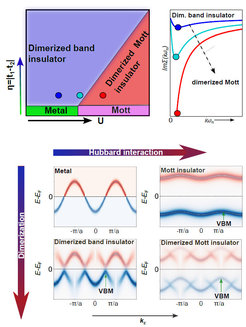A Decades-Old Puzzle Solved: New Signature Reveals Mechanism Behind Insulating Behavior - Key to a Mysterious Superconducting Effect?
A longstanding challenge in condensed matter physics - distinguishing between two fundamentally different types of insulators - may finally have a solution. An international research team led by Dr. Niels Schröter at the Max Planck Institute of Microstructure Physics in Halle, Germany, has identified a distinctive, momentum-resolved spectral signature that uncovers strong electron correlations in the layered material Nb₃Br₈. Their findings, published in Nature Communications, mark a crucial step toward understanding the mechanisms behind insulating behavior in crystalline solids - a question that has puzzled physicists for decades.

In solids, insulating behavior can arise in two fundamentally different ways: electrons may scatter off the regular arrangement of atoms, forming a band insulator, or they may localize due to strong mutual interactions, creating what is known as a Mott insulator. For materials with an even number of electrons per unit cell, both scenarios are theoretically possible, but experimentally telling them apart has proven to be a major challenge. “Our work provides the first clear, momentum-resolved fingerprint that distinguishes these two cases,” explains Dr. Schröter. “We’ve uncovered a unique spectral feature in Nb₃Br₈ that reveals it as a Mott insulator, overturning previous assumptions that it was simply a band insulator.”
This discovery is far from just an academic milestone. Nb₃Br₈ has gained considerable attention for exhibiting a puzzling magnetic field-free Josephson diode effect—a superconducting phenomenon that breaks time-reversal symmetry without any external magnetic field or any magnetic material—observed at the Max Planck Institute in Halle in 2022. Until now, the origins of this effect have remained mysterious. The new findings suggest that strong electron correlations in Nb₃Br₈ may be the missing piece of the puzzle.
The breakthrough centers on precise measurements of the material’s electronic band structure. Dr. Schröter’s team demonstrated that in the Mott-insulating state, the top of the highest occupied band along the material’s out-of-plane direction is separated in momentum space by Δkz = 2π/d, where d is the spacing between atomic layers. In contrast, a band insulator would show a separation of less than π/d. This clear, quantitative distinction offers a powerful new tool for studying quantum materials - especially van der Waals heterostructures, where interlayer coupling can be tuned to induce a transition between insulating phases.
PhD student Mihir Date, who led the experimental efforts, describes the journey as a “beautiful rollercoaster ride.” “When I started, we were focused on identifying surface states in Nb₃Br₈,” Date recalls. “But after several unsuccesful attempts, we stumbled upon an unexpected clue: the out-of-plane dispersion didn’t match the periodicity expected from the lattice structure. That’s when we realized the real story was in its strong electronic correlations.” Date adds: “Looking back, I feel incredibly fortunate that our hard work and close collaboration with colleagues from our institute, the Max Planck Institute in Dresden, the Martin-Luther University in Halle, as well as our excellent theoretical partners in Switzerland at the Paul Scherrer Institute, the University of Fribourg, and the University of Geneva, all paid off.”
Beyond solving a decades-old experimental challenge, the new method could pave the way for observing quantum phase transitions between band and Mott-insulating phases in layered materials—an exciting prospect for designing next-generation superconducting devices. “Our findings not only resolve a longstanding experimental question,” Dr. Schröter emphasizes, “but also open new avenues for exploring the interplay of electron correlations and superconductivity in low-dimensional systems.” This work highlights the vital role of cutting-edge spectroscopic techniques and international collaboration in advancing the frontiers of quantum materials.












